This post may contain affiliate links. Please read our disclosure policy.
Soft homemade gluten free dinner rolls that are quick and easy enough for busy weeknights, but still fit for any holiday table or celebration. Never go without bread again!
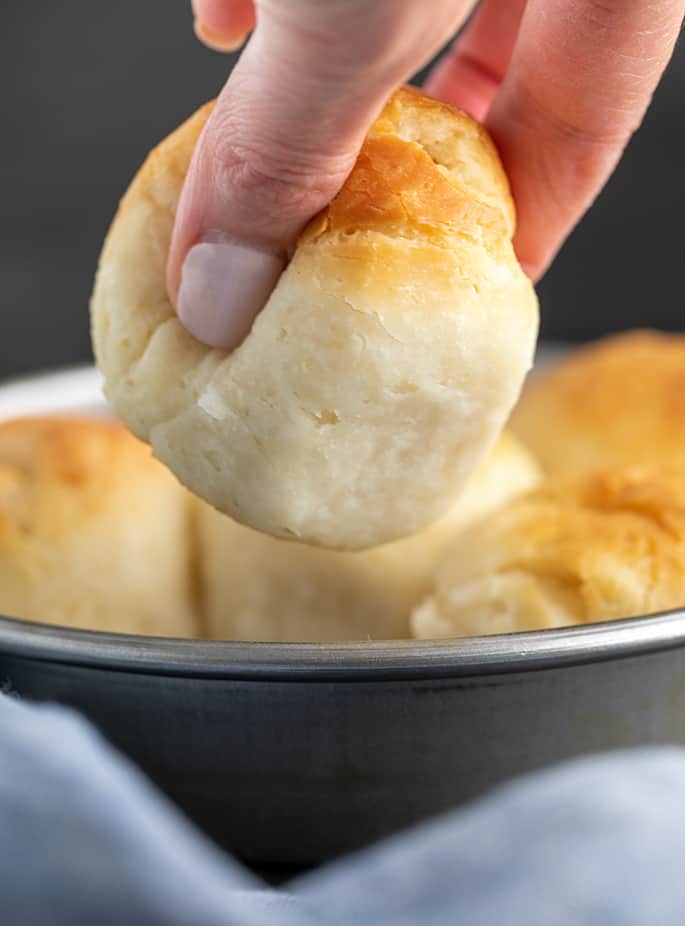
Table of Contents
- Why this is the best gluten free dinner rolls recipe
- What's the best gluten free flour for these gf dinner rolls?
- How to get gluten free dinner rolls to rise
- More tips for making the best gluten free rolls
- Gluten free bread rolls: storage tips
- Gluten free dinner rolls: substitutions
- FAQs
- Gluten Free Dinner Rolls Recipe | Soft, Squishy Yeast Rolls
Why this is the best gluten free dinner rolls recipe
These rolls are highly enriched, which just means that they have plenty of butter and milk in the recipe. Plus, the addition of nearly 1 full cup of tapioca starch helps provide a lot of stretch to the rolls, as baked, and makes the dough very easy to shape with almost no added flour.
These gluten free dinner rolls are soft and squishy, so they're ideal for serving with any homestyle meal. Imagine them on the side of your plate of gluten free meatballs, since they're easy enough for a weeknight.
They're also perfect for your holiday table. I've made our recipe for gluten free Texas Roadhouse rolls many times for Thanksgiving, but they're more of an appetizer-type roll.
For our next holiday season, I think I'll be making this gluten free rolls recipe as they're made for soaking up the last bits of gluten free gravy from that holiday plate.
What's the best gluten free flour for these gf dinner rolls?
To make gluten free bread, the base blend I recommend is Better Batter or my mock Better Batter all purpose gluten free flour blend.
Even when our bread recipe calls for our gluten free bread flour, which we’re not using here, the base is (mock Better Batter). It has the right balance of gluten free flours when you need a recipe to hold its shape during rising and baking.
Adding nearly a full cup of tapioca starch/flour to the recipe lightens the gluten free rolls without diluting the strength of Better Batter. It also provides elasticity to the raw dough, which makes for easier shaping, and to the baked rolls.
If you can’t have tapioca starch/flour, you can try replacing it both in the mock Better Batter and as a separate ingredient in this recipe with superfine glutinous rice flour (which is just rice flour made from starch, short-grain white rice). I have had some success with that substitution, but can’t promise results.
More gluten free yeast roll ingredient notes
- Instant yeast – This recipe calls for instant yeast, but if you don't have any on hand or would prefer to use active dry yeast, you’ll need to hydrate the yeast first in some of the milk. You’ll also need 15 grams of active dry yeast rather than just 12 grams of instant yeast.
- Sugar – The primary role of the sugar is to “feed” the yeast so that your gf rolls come out big and fluffy. But the sugar also complements the salt in this recipe, giving you that delicious balance of flavors.
- Milk – Warm milk activates the yeast, so it can start feeding and doing its thing. It's important that the milk isn't too hot; otherwise, you'll kill the yeast and won't get your rise.
- Butter – Butter adds richness to these easy gluten free rolls and also helps with their rise.
- Egg whites – These egg whites contribute a lot to the recipe: they add structure, assist with the rise, and they help the gf yeast rolls hold their shape.
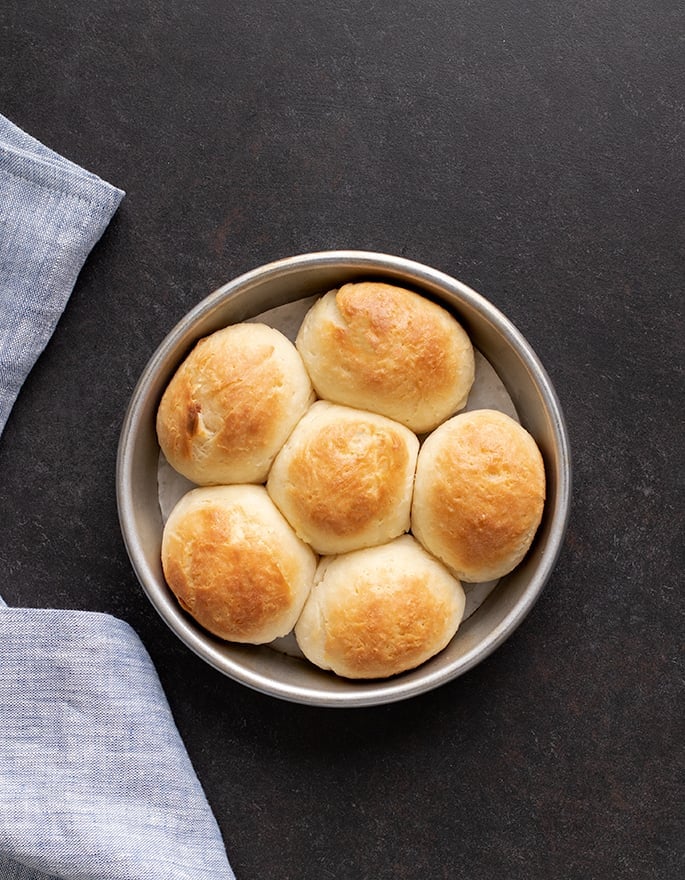
How to get gluten free dinner rolls to rise
This is a yeasted gf bread recipe, so you must provide a proper environment for the commercial yeast to reproduce after it’s exposed to the milk in the recipe. Yeast rises at a very high range of temperatures.
The desired dough temperature appears to be 78°F, but I don’t spend much of any time worrying about that. I typically set yeasted dough to rise on top of my oven (never inside), and turn the oven on to about 300°F. The ambient heat provides just enough warmth to help the dough rise uniformly.
Yeasted dough will rise at lower temperatures, even in the refrigerator at 40°F, just more slowly. A slower rise creates more of that somewhat sour, yeasty flavor in the dough, and is best for leaner, non-enriched bread doughs that don’t have much, if any, fat.
The worst placement for getting rolls to rise is somewhere too hot. Slow-rising dough can be very frustrating, but a too-hot temperature risks killing the yeast and preventing any rise at all.
Enrichments like the milk, egg whites, and butter in these gluten free rolls help the dough rise more quickly. But rising times for yeasted dough like these dinner rolls can vary significantly.
A dry climate will also inhibit yeast growth, so you can try adding a tablespoon of additional warm milk or water to the dough if you tend to struggle with getting yeast dough to rise. Don’t add too much, though, or the rolls are likely to overproof and then deflate as they cool (leaving them gummy inside).
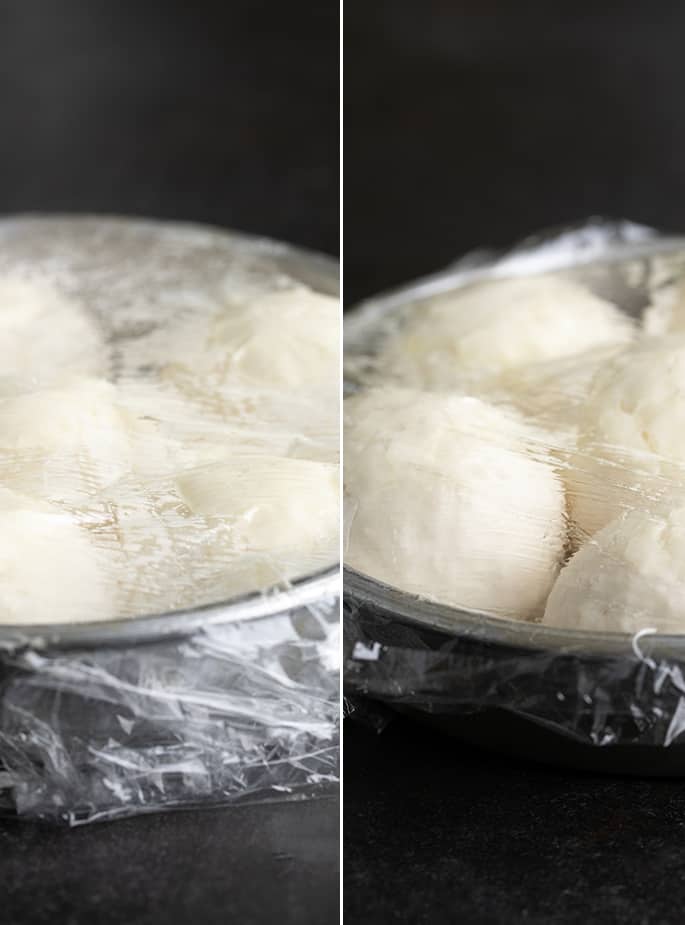
More tips for making the best gluten free rolls
Measure out your gluten free flour correctly
If you've tried some of my other gluten free bread recipes, you've likely seen this tip — that's because it's such an important one. The success of your gluten free baking really relies on precision. If you want to achieve the same results I do, you need to do exactly as I do.
When it comes to gluten free flour, you want to ensure you use precisely the amount that I do. That's impossible to achieve with a measuring cup, but it's very easy to do with a kitchen scale.
Definitely use a stand mixer
You really need to use a stand mixer for this gluten free yeast rolls recipe. It's honestly the only way to ensure you get the smooth dough that's necessary for the fluffiest, squishiest rolls.
If you don’t have a stand mixer, you can get away with using a food processor fitted with a steel blade.
Unfortunately, a hand mixer won't work, and there's absolutely no way to adequately mix this dough by hand.
Eat your homemade gluten free rolls right away
Eat your gluten free baked goods straight from the oven! That's not something you'll see me say often, if ever. But that's really what you should do with these gluten free rolls.
Unlike other gluten free bread recipes, these rolls are meant to be eaten quickly. They come out of the oven maintaining their shape, so you don't have to worry about them deflating or falling apart.
Worried that you won't be able to scarf down all these rolls in one sitting? Consider halving the recipe by cutting every single ingredient amount in half.
If you make 8 rolls instead of 16, you probably won't have any trouble eating them all before night's end. Only baking for 1 or 2? Try cutting the recipe down to 25%.

Gluten free bread rolls: storage tips
Storing leftover gf dinner rolls
While I don't recommend it, you can store leftover rolls if you made too many. Because yeast breads tend to get harder the longer they sit around, you want to take care to make sure you store your rolls in an airtight container.
They'll stay good at room temperature for around 2 days, and I suggest sprinkling them lightly with water and then popping them into the microwave for 10 or 15 seconds or the toaster oven at 300°F for a few minutes to refresh them before eating.
Making gluten free yeast rolls in advance
From start to finish, this gluten free bread rolls recipe takes about 2 hours to complete. This means these rolls aren't something you can whip up last minute.
I know what you're thinking: “I'll just make the dough and freeze it until I need it!” But I don’t ever recommend freezing raw yeast dough. It may not rise after having been frozen.
“That's okay,” you say. “I'll leave the dough in the fridge until I need it!” I also don’t recommend letting the dough rise in the refrigerator for more than 24 hours, as the oven rise tends to be very irregular during baking when you do that.
So what do you do when you want to make gluten free rolls ahead of time? Parbake and freeze. Using this method, your dinner rolls will last at least a month.
How to parbake these gf rolls
To parbake the rolls, follow the recipe through baking (be sure to separate the raw rolls, leaving about 2-inches between one another), but only set the oven to 300°F. Bake for about 15 minutes or until the rolls appear puffed and are no longer wet inside.
Remove the rolls from the oven, and allow them to cool completely. Freeze in a single layer, and then wrap tightly in freezer-safe wrap. Eliminate as much air as possible, as air is what causes freezer burn.
When you're ready for your dinner rolls, just defrost them at room temperature and then finish baking them at the original 375°F until fully browned and 190°F inside.
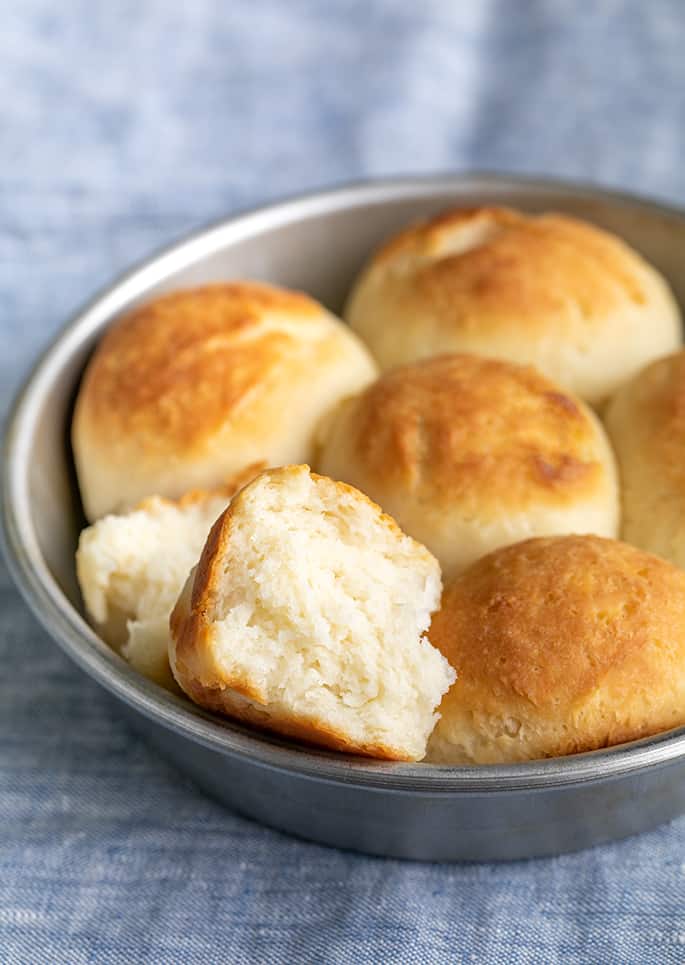
Gluten free dinner rolls: substitutions
Gluten free, dairy free dinner rolls
If you can’t have dairy, try replacing the melted butter with melted vegan butter. Melt and Miyoko’s Kitchen brands are my favorite.
In place of dairy milk, any unsweetened nondairy milk should work. Avoid using anything nonfat, though, as richness is the goal.
Gluten free, egg free dinner rolls
There are 2 egg whites in this recipe, and they provide structure to the rolls. You may be able to replace them with aquafaba, or the brine from a can of unsalted chickpeas.
Sometimes aquafaba is a perfect substitute for egg whites in baking, and other times it appears not to work. I’m afraid I’m not experienced enough in this sort of substitution to predict the likelihood of success.
How to use active dry yeast instead of instant yeast in these gf rolls
I always bake with instant yeast (which is also called bread maker or rapid rise yeast) in yeasted recipes like this one. You cannot eliminate the yeast in this recipe, but you can make dinner rolls with our recipe for yeast free gluten free dinner rolls.
You cannot replace the yeast in this recipe with wild yeast sourdough. Sourdough recipes are entirely distinct.
If you prefer to use active dry yeast, you’ll need to use more, and to “proof” the yeast in some of the milk first. The general rule of thumb is to use 25% more active dry yeast than instant yeast, by weight. Here, that’s 15 grams of active dry yeast in place of 12 grams of instant yeast.

FAQs
there are a lot of reasons why your gf dinner rolls may not have risen. Most can be traced back to not following my recipe to a point. Here are some examples:
– Using too much flour will reduce the hydration ratio of the dough, preventing the yeast from activating; not using enough sugar won't give the yeast the food it needs to do its job.
– Improper temperatures: If your milk is too cold, it will slow down activation of the yeast; if it's too hot, it will kill it. You also won't get a good rise if you leave your gluten free yeast dough in the fridge without a tight-fitting lid or in a drafty part of the kitchen.
– Expired yeast: Bad yeast can also be a culprit. If you're not sure whether yours is good, add a bit to a mixture of warm water and sugar. If it's not frothy after 10 minutes, your yeast is no good
Dense gluten free rolls are usually the result of too much flour. This is why I always suggest that you measure yours out using a kitchen scale rather than rely on a measuring cup. Be careful, as well, about incorporating too much flour into your rolls during shaping, which will also lower the hydration ration and reduce or eliminate yeast activity.
Yes, making and freezing gluten free buns is a great way to save time.
To do this, follow my instructions above for shaping and parbaking your rolls. Freeze them once they're completely cool, and then let them defrost before popping them back into the oven to finish baking before dinner.
If you only have active dry yeast, you can use it here but you'll need to use 25% more per recipe, and to dissolve it in some of the milk before combining the milk into the other ingredients. Here, the recipe calls for 12 grams of instant yeast, so you'd need 15 grams active dry yeast.
Yes, yeast absolutely can and does work with gluten free flours. The secret to getting your gluten free dough to rise is to take exacting care when measuring out ingredients and use the proper gluten free flour blend, as specified in the recipe.
No! The recipe calls for both the amount of flour blend stated plus additional tapioca starch as an additional ingredient. You can never just leave out any ingredient in any recipe and expect results, unless that ingredient is listed as optional. All good quality all purpose gluten free flour blends contain tapioca starch; this recipe calls for more than the average, all purpose amount.
No, these rolls will not hold their shape if you shape and then let them rise for that long, even in the refrigerator.
Gluten Free Dinner Rolls Recipe | Soft, Squishy Yeast Rolls
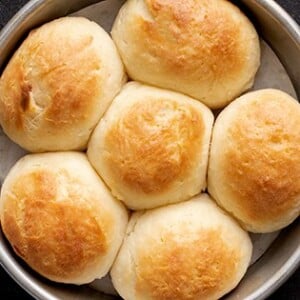
Ingredients
- 3 ¼ cups (455 g) all purpose gluten free flour blend, flour blend is particularly important here; click through for recommended flour blends
- 3 ¼ teaspoons xanthan gum, omit if your blend already contains it
- ⅞ cup (105 g) tapioca starch/flour, plus more for sprinkling
- 4 teaspoons (12 g) instant yeast, See Recipe Notes
- ¼ cup (50 g) granulated sugar
- 1 teaspoon kosher salt
- 1 ⅝ cup (13 fluid ounces) warm milk (about 90°F)
- 8 tablespoons (112 g) unsalted butter, melted and cooled (plus more for brushing)
- 2 (50 g) egg whites, at room temperature
Instructions
- In the bowl of a stand mixer (See Recipe Notes), place the flour, xanthan gum, tapioca starch/flour, instant yeast, and granulated sugar, and whisk to combine well. Add the salt, and whisk again to combine.
- Add the milk, melted butter, and egg whites. Using the paddle attachment, beat vigorously. The mixture will come together in a clump and clear the sides of the bowl. Keep beating until it begins to look whipped, and sticks to the side of the mixing bowl again (about 6 minutes total).
- Transfer the mixture to a lightly oiled bucket or bowl with a very tight-fitting lid. The container should be large enough for the dough to nearly double (although it won’t double fully).
- Set the container aside for at least 2 hours at room temperature, and up to 24 hours in the refrigerator. Do not let the dough rest/rise for too long, or your rolls will rise much more irregularly after shaping.
- If you’ve let the dough rest in the refrigerator, remove it from the cold and place it, still covered, on the kitchen counter. Allow it to warm to room temperature before working with it.
- Grease a quarter sheet pan or multiple round cake pans for baking, and set them aside. You will later decide if you’d like to crowd the rolls, and have them rise then bake touching, or have them separate.
- Divide the dough into 16 equal portions, each 2 1/2 ounces in weight. Working with one piece at a time, knead the dough in your clean, dry hands, without adding any additional flour of any kind, pinching any seams that separate.
- Flour a clean, dry work surface very lightly with tapioca starch, and coax the dough into a round. The dough should be firm, but easy to work with.
- Place the shaped rounds of dough in your chosen baking pan either touching (they will rise mostly up), or a bit more than 1-inch apart, taking care not to crowd them (the will rise up and out).
- Cover the pan with lightly greased plastic wrap, place in a warm, draft-free location, and allow to rise until about 150% of their original size.
- This rise can take anywhere from 45 minutes to hours, depending upon the ambient temperature in your kitchen. Overproofing is not very likely, and can be detected when the surface of your raw rolls begins to take on a pockmarked appearance.
- When the rolls are nearing the end of their rise, preheat your oven to 375°F. Once the rolls are properly risen, remove the plastic wrap from the pan(s), and brush generously on all exposed sides with melted butter.
- Place the baking pan(s) in the center of the preheated oven and bake until an instant read thermometer inserted into the center of each roll reads about 190°F.
- If there is any space between the rolls after they’ve risen, they will take around 20 minutes until fully baked.
- If the rolls are touching one another, lower the oven temperature to about 350°F at 18 minutes and continue to bake for about another 5 minutes or until the proper internal temperature is reached in the center roll.
- Remove the pan from the oven, and with the rolls still in the hot pan, brush again with melted butter and serve immediately.
Video
Notes
If you’d like use active dry yeast in place of instant yeast, you’ll need to hydrate the yeast first in some of the milk. You’ll also need 15 grams active dry yeast to replace 12 grams of instant yeast. For the stand mixer
If you don’t have a stand mixer, I recommend making the dough in a food processor fitted with the steel blade. I don’t recommend a hand mixer, or trying to mix by hand. Originally published on the blog in 2021; in 2022, some text resources added, but recipe, photos, video unchanged. Nutrition information. Nutrition information is an estimate, per roll, and is provided as a courtesy created using an online nutrition calculator. It should not be relied upon.
Nutrition
Nutrition information is automatically calculated, so should only be used as an approximation.
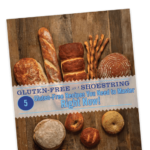
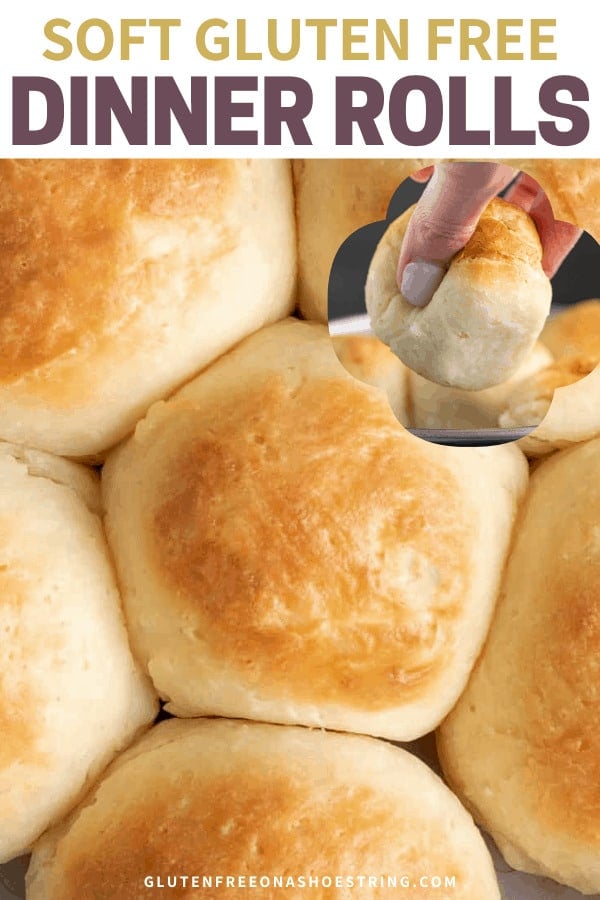
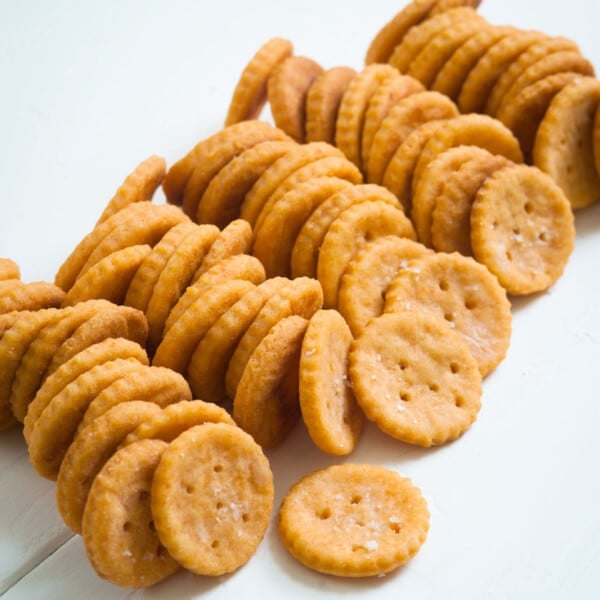
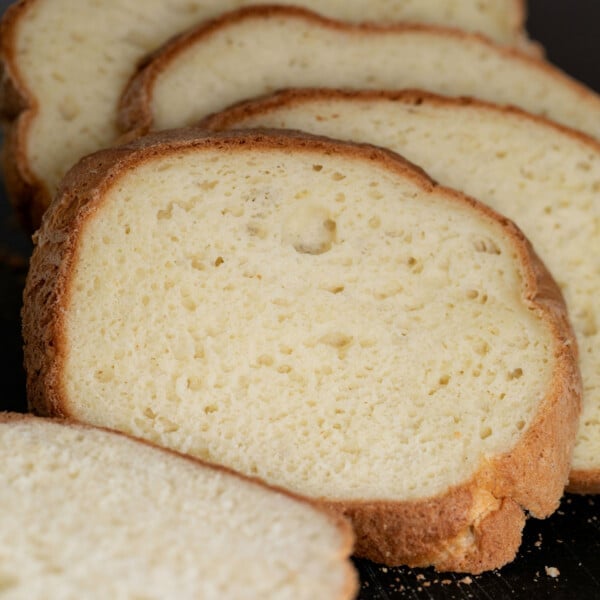
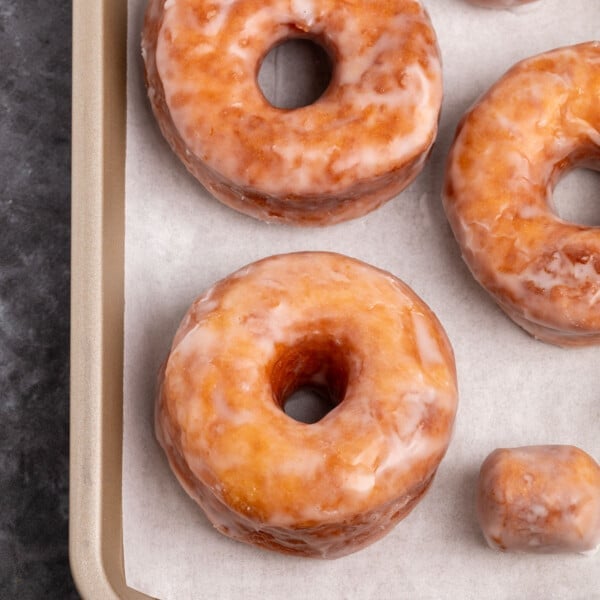
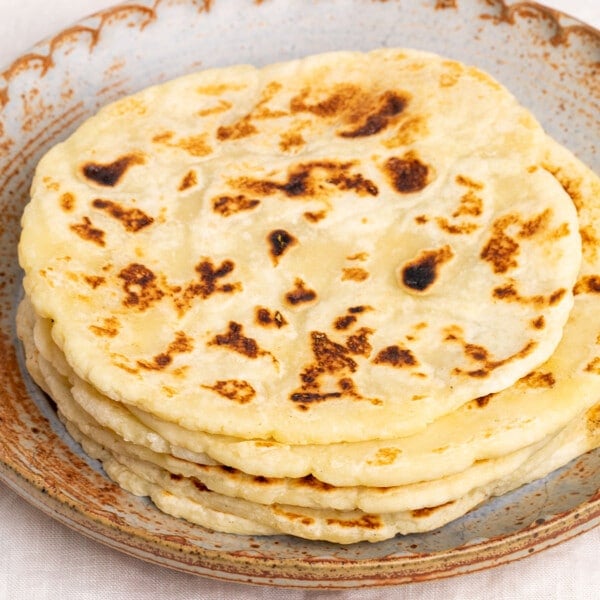









These rolls are wonderful! The first time I made them they came out a little dense because I didn’t give them enough room to rise and the brand of yeast I had was a brand I don’t usually use. Even then they were still delicious. So I tried them again and let them rise in a larger container with better yeast and they came out PERFECT. I used Better Batter flour blend and didn’t make any substitutions. Such an easy and beginner friendly recipe and a spectacular result!
I’m really glad to hear that, Grace. Thank you so much for sharing your experience, and I’m really glad you were able to diagnose your original issue. I think that’s why I think of yeast bread as a bit of art along with the science. Well done!
I have made this recipe 3 times now and have used coconut oil rather than butter to make it dairy free. The gf flour I use is Pamela’s Bread Flour. The rolls have turned out amazing every time my husband was shocked when I told him they were gf and dairy free. I found the dough had the best texture for shaping when I make it the night before and refrigerated it. Then I pull it out about 2-3 hours before I am ready to work with it. I added saffron and rolled them into Lucia Buns today. I love this recipe and what a gift to let my son eat his favorite food again, bread. Thank you.
I’m glad to know that your coconut oil swap for butter worked well, Merissa. Glad you’re enjoying the bread recipe!
I am obsessed with your gluten-free Japanese milk bread and literally have made it a million and one times since my discovery. I had been searching for a gluten-free yeasted bread that mimicked the same scrumptious ones I knew in childhood, and the milk seemed to be the IT factor as far as producing a soft, buttery texture. How are these in comparison? And/or could I use the Japanese milk bread dough to make dinner rolls with as well? Should I shape by hand or is it best to bake them in muffin tins, as I know many gluten-free doughs lose their shape unlike traditional doughs. Thank you in advance! Looking for some holiday yeasted dinner rolls for the holidays this year!!
These don’t lose their shape at all, Vanessa, which you can see from the photos. I’m really glad you enjoy the Japanese milk bread recipe. I would recommend this recipe for dinner rolls, as you might imagine!
Is that 2 egg whites that are 50 grams each (totaling 100 grams), or 50 grams of egg whites total, and it’s about 2 egg whites?
In all recipes, the number in parentheses is the weight measurement alternative to the volume measurement, Pat. So it’s a total of 50 grams.
That’s what I thought, based on how the other ingredients were setup, but I just wanted to make sure, since the recipe isn’t turning out correctly for me, so I wanted to make sure that I had that part right, as I’m trying to see what I might’ve done wrong. Thanks!
Here are my usual suggestions for you to investigate, Pay: Everyone says that they “followed the recipe to a T” but it’s rarely the case, in ways you just don’t realize are important, but are. Here are some considerations and questions to ask yourself as you attempt to figure out where you deviated from the recipe as written:
Did you make ingredient substitutions, particularly the gf flour blend? They are not all created equal at all. Please see the AP GF flour blends page, which is linked in every recipe that calls for one.
Did you measure by weight, not volume? You can’t measure properly by volume, especially dry ingredients like flour, as human error is unavoidable.
With respect to yeast bread, did you allow the dough to rise long enough, and was your dough covered properly? Overproofing is a function of rising too much, not too long. It can take a long time for yeast bread to rise properly in a cool, dry environment, especially. You must also be sure that any refrigerator rise is done in a container that is well-sealed, or the bread will dry out and not rise due to lack of moisture. And watch the how-to video to see what texture you should expect from the dough right out of the bucket, and then as you shape it. It will not be as you expect from conventional gluten-containing bread dough.
Hi! I’m loving your recipes that I’ve tried so far! They’re all so delicious! I made these rolls, and the flavor is delicious, but they’re dense. I followed the recipe, and I even used your mock better batter flour with the super fine rice flours. The first rise seemed good, but once I shaped them, they didn’t seem to rise much, and I had them in a warm place for a long time. Do you have any ideas of what I might have done wrong, and what I could do better next time?
Here are the questions I recommend asking yourself when yeast bread doesn’t rise as expected, Allison: Did you measure by weight, not volume? You can’t measure properly by volume, especially dry ingredients like flour, as human error is unavoidable. With respect to yeast bread, did you allow the dough to rise long enough, and was your dough covered properly? Overproofing is a function of rising too much, not too long. It can take a long time for yeast bread to rise properly in a cool, dry environment, especially. You should also check your yeast to make sure it’s fresh, and make sure you’re using instant yeast, not active dry. It’s also called breadmaker or rapid-rise yeast.
Thanks for the reply! I did measure them by weight! :) and, I did the first rise for 2 hours, since you said it needs to be risen for at least 2 hours the first rise. I’m wondering if it was too hot for the second proof. I had my inside oven on 300 degrees, but instead of putting my pan on the center of the stovetop, I put it towards the back where the heat comes out. Since we have a gas stove, the actual stovetop doesn’t get super warm from the inside, except in the back. But, I’m wondering if it was maybe too hot? Unless, I did something wrong with the first rise, but I did it for 2 hours. My yeast was fresh. I’d just gotten it at the store, and I made sure the expiration date wasn’t passed! Do you have another idea of where I could do the second rise, since maybe the stovetop might not work with out gas oven?
I don’t ever recommend artificially heating the environment like that for yeast bread rising, Allison, as it’s easy to increase the temperature of the yeast so much that it dies, like it does in the oven. Yeast will be active at quite a range of lower temperatures, just more slowly. That’s why it rises in the refrigerator. You also need to ask yourself if your dough became dried out at any point in handling it. You should be using very little flour to shape it, or you lower the hydration ratio which inhibits and sometimes prevents rising.
I made the rolls again yesterday, and they were less dense. I live in a dry place, so maybe I’ll try doing the additional tablespoon of warm milk in my dough, like you mentioned in the recipe. I was wondering, what # of speed do you mix the dough on? Your recipe says to mix it vigorously, so I did a high speed, but I’m wondering if maybe I over beat it? My dough didn’t do the thing where it sticks to the sides of the bowl at the end of the 6 minutes like yours does. It kind of did a tiny bit the second time I made it, but not like in your video.
We loved these rolls! I am NOT a professional baker by any means, and this is the first gluten free bread I have ever attempted from scratch. My husband, who we just found out is celiac, said they were great and my dad (who is not celiac) said he would eat them over regular rolls any day! I weighed all of my ingredients, temperature-checked everything and essentially followed your recipe to a T. The only deviation was I added a little extra flour at mixing because my dough was really wet for some reason. I also definitely overcrowded my pan (lesson learned) so they took a little longer to cook and ended up a little dense. But they were crispy on the outside, soft and chewy on the inside and the flavor was delicious – a little on the yeasty side and 100% tasted like normal, homemade white bread. They are a labor of love but I will definitely make them again in the future!
The denseness could also have been a function of your having added more flour, Alexa, particularly before shaping, as that lowers the hydration ratio. As I mentioned to another commenter, you may have to adjust your expectations for how wet gluten free yeast bread dough is as compared to conventional bread dough. It has to be a bit sticky or it won’t have enough moisture for the dough to properly rise. You’ll get there!
I followed all the steps – no substitutions, and I measured everything with a scale. I used Better Batter flour (The one with xantham gum already in it). But after the first rise (2 hrs, dough almost doubled), the dough is so sticky it’s impossible to work with. I can’t think of anything I did wrong. Maybe I had the mixer on for too long or not long enough?
Raw gluten free yeast bread dough is always going to be somewhat sticky or it won’t have enough moisture to rise, Leah, so perhaps it’s just your expectation of how easy the dough will be to shape? I’m afraid I don’t know where you may have deviated from the recipe as written, but watching the how-to video might help?
Is there a how-to video linked on this recipe? I couldn’t find it anywhere – but that definitely might help! The dough was so wet I just had to scoop it out with a spatula or else it would just be all over my hands. I just plopped it onto some tapioca starch and was able to carefully prod it into a round shape. They weren’t bad, but I do feel like I went wrong with the texture somewhere. I followed the recipe 100%, except I used oat milk instead of regular milk.
Yes, Leah, there is a how-to video but you won’t see it, or any of the other videos, if you don’t turn off any ad blockers you might be using. I expect that my readers don’t use ad blockers, anyway, since ads are the only way I get paid for my hard work in developing these recipes, and sharing all the details about how to make them. In addition, if your oat milk is not the thin, smooth consistency of cow’s milk, I recommend against using it as a cow’s milk substitute. It won’t have enough moisture if it’s thick.
My dough was very sticky as well (too much to handle at all), BUT I poured a bit of olive oil in a plate and added a bit of oil to my hands before I rolled each piece and it worked perfect! Hopefully that helps <3
This bread is delicious! It has a slightly sweet smell and taste. I followed the recipe pretty close except for allowing the bread to stay in the fridge for 24hrs. I was too impatient. I took it out at 18hrs. I used the mock better batter recipe and the bread flour recipe using expandex. I also used guar gum instead of xanthan gum because I have a corn sensitivity. After I formed the dough into rolls, I let them proof in the round pan on top of the stove and turned the oven on so that the stove top would get warm. It worked perfectly! My rolls remind me of a cornbread texture but not crumbly, which I’m perfectly fine with. I’ve been on an elimination diet and haven’t had bread in months! Thank you for the recipe!
Cyn, this recipe is not developed to be made with my bread flour blend. There’s too much liquid in it, and the cornbread texture you’re describing is due to all the substitutions. I’m glad you’re happy with the results, though!
Thanks. With your recipe I finally could make, with some adjustments. low carb buns. I used almond flour and kokos flour, fiber husk, erythritol and a lot more milk and a bit of water. Your comment on how much fluid gluten-free dough needs to rise has helped me to feel the dough to make certain that the flour and fluids are in balance so that the dough rises correctly. I am a fan of your recipes. My daughter has to eat eat gluten-free. Every recipe I have tried from your books has worked out perfectly. I eat low carb because of my bloodsuckers. Your experience with gluten free baking has helped me a lot to bake almost everything.
Greetings from the Netherlands
Hi, Riemke, I’m really glad you’re pleased with your results. For others’ sake, that’s really an entirely different recipe with that many substitutions and I’m afraid I can’t promise results if you’re making my recipes with anything other than an all purpose gluten free flour blend as defined on my gf flour blends page.
I tried making this recipe twice, carefully weighing out all ingredients. The rolls were like rocks – very dense and unpalatable. I even tried letting the dough rise 3 times instead of just once. The only difference between the recipe and what I did was substitution of buttermilk for whole milk (didn’t have milk on hand). Don’t know what went wrong, but they were far from light.
Buttermilk has significantly less moisture than milk, Signe, which would easily account for the lack of rise. Without proper moisture, yeast bread will not rise. I’m removing the star rating as you didn’t follow the recipe, so it’s not a proper representation. I would also, as always, look at your flour blend, measuring by weight, all the of the things I stress in every yeast bread recipe.